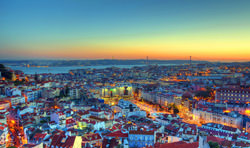Car Rental at 'Corroios'
'Corroios': Hiring Vehicle
Searching best rental offer in Lisbon
You can specify required rental date and time, vehicle category, pick-up/return location criteria in the white form above. In case your return location is different from the pick-up location, check the box 'Different Drop Off Location?'.
The preset location address: R Armando Guerreiro 3a Santa Marta Do Pinhal , Corroios , 2855 597, Portugal, area 'Corroios'.
Alteration of the current rental location can be performed in three ways:
-by entering your desired destination in the 'Pick-up' field;
-by following the links to location pages shown below;
-by using the Lisbon interactive map on the left.
Rental hints for Lisbon
Car and options choice. The search results indicate valid and final rental rates at the 'Corroios' location. The rates are formed on the 'All included' principle. Presented prices do not include additional options, such as a GPS navigator, child seats, winter tires, etc. They can be added later on, during the last phase of the booking process.
Hiring conditions are different for each rental car in Portugal. Therefore, before making a reservation, make sure you haveve read the conditions. The reservation is performed in three quick steps: searching for a car by location and rental dates, selecting desired vehicle and filling in the booking form. Upon reservation approval, you will receive a rental voucher via email.
Car pick-up. Upon arrival to the location 'Corroios', provide the required documents specified in your voucher to the rental officer. Directly in the office, inspect the rental invoice carefully – should match with your voucher. Besides this, do not forget examine the car exterior carefully – all defects discovered at the pick-up time should be included in your rental document.
Car return. Make sure to return the vehicle within the specified timeframe and to adhere to the fuel conditions (return full or return empty).
OrangeSmile.com wishes you a pleasant and trouble-free driving in Portugal!
Frequently asked questions on the rental process
Hiring conditions are different for each rental car in Portugal. Therefore, before making a reservation, make sure you haveve read the conditions. The reservation is performed in three quick steps: searching for a car by location and rental dates, selecting desired vehicle and filling in the booking form. Upon reservation approval, you will receive a rental voucher via email.
Car pick-up. Upon arrival to the location 'Corroios', provide the required documents specified in your voucher to the rental officer. Directly in the office, inspect the rental invoice carefully – should match with your voucher. Besides this, do not forget examine the car exterior carefully – all defects discovered at the pick-up time should be included in your rental document.
Car return. Make sure to return the vehicle within the specified timeframe and to adhere to the fuel conditions (return full or return empty).
OrangeSmile.com wishes you a pleasant and trouble-free driving in Portugal!
Frequently asked questions on the rental process
Typical models of OrangeSmile.com vehicles in Lisbon
Rental locations near Lisbon
Over the sights of Lisbon by car
A vivid Portuguese Baroque masterpiece is the Panteão Nacional built in 1682. Many prominent figures of the country such as presidents and writers are buried here today. Formerly, until 1966, the building was a church. The Palácio Chiado dating back to 1781 was once a magnificent palace. Today, it houses a fine restaurant, the dream of any history buff. Sitting here, one can get an idea of how noble parties were organized and things were done here in the old days. One of the most prestigious theaters in Portugal is the Teatro Nacional Dona Maria II. Foreign ambassadors had lived here in the 15th century and inquisitors in the 16th century, until the 1836 fire have almost completely destroyed the building. Later, it was decided to build a theater on its site.
Read further...
Common questions
Rental conditions
Payment
Changing your booking
Cancelling your booking
Confirmation voucher
Crossing borders
Fuel conditions
Age restrictions
Extra services
Insurance types
Driving license
What does the price include
Payment
Changing your booking
Cancelling your booking
Confirmation voucher
Crossing borders
Fuel conditions
Age restrictions
Extra services
Insurance types
Driving license
What does the price include
HELPDESK
+31 4040 15044
support@orangesmile.com
YOUR BENEFITS
BEST PRICE GUARANTEE
WIDE CHOICE: 25000 HIRE POINTS
BOOKING IN 3 SIMPLE STEPS
INSTANT CONFIRMATION
ONLINE SUPPORT
500.000+ SATISFIED CLIENTS








Car Types
Car hire in Portugal
» Lisbon: 19 rental offices
» Funchal: 7 rental offices
» Porto: 7 rental offices
» Faro: 4 rental offices
» Aveiro: 3 rental offices
» Penafiel: 3 rental offices
» Imao: 3 rental offices
» Angra Do Heroismo: 3 rental offices
» Sao Miguel: 3 rental offices
» Madeira: 3 rental offices
» Horta: 3 rental offices
» Lagos: 3 rental offices
» Praia Da Vitoria: 3 rental offices
» Barcelos: 2 rental offices
» Ponta Delgada: 2 rental offices
» Funchal: 7 rental offices
» Porto: 7 rental offices
» Faro: 4 rental offices
» Aveiro: 3 rental offices
» Penafiel: 3 rental offices
» Imao: 3 rental offices
» Angra Do Heroismo: 3 rental offices
» Sao Miguel: 3 rental offices
» Madeira: 3 rental offices
» Horta: 3 rental offices
» Lagos: 3 rental offices
» Praia Da Vitoria: 3 rental offices
» Barcelos: 2 rental offices
» Ponta Delgada: 2 rental offices











